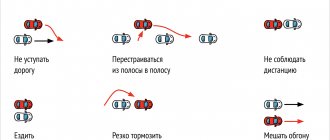Home / Autolight
Back
Published: 03/31/2021
Reading time: 7 min
0
422
- Why tint the taillights on your car?
- What is needed for tinting
- Advantages and disadvantages
- How to choose a tint film
- Tinting process
Tinting taillights is a simple process, but it requires care and compliance with all recommendations for carrying out the work. In order not to receive fines for violating traffic rules, you need to choose a film of not very dark colors. We must remember that the brake light should always be red and the turn signals should flash yellow or orange.
Headlight tinting: types of monetary penalties
You can tint the front or rear lights, or all at once. The color of the coating can be bright red or match the tone of the car. The headlights can simply be covered with a colorless film, protecting the surface of the device.
The following sanctions are provided:
- penalty for incorrect tinting of headlights - 3,000 rubles (more than 15% of light transmittance);
- penalty for tinting rear lights - 500 rubles.
And then we will consider the various options.
Why do you need tinted rear lights?
Of course, most car owners use headlight tint to make their car look more attractive. After all, this is the simplest and most affordable way to make a car much more impressive and give it a unique style. And if you want to return the car to its original appearance or change the design, you can easily and quickly get rid of the paint at any time without the help of specialists.
However, tinting the rear lights yourself can also help in eliminating some of the inconsistencies in the traffic rules of different countries. Thus, many owners of American-made cars are faced with the fact that the brake lights on their cars are orange, while according to our traffic regulations they should be exclusively red. A red tinting varnish will help solve the problem, which in this case is applied only to the surface of the brake light.
It should be remembered that only light tinting of the rear lights is suitable for participation in road traffic. A more intensive option is applicable only for exhibition tuning and various auto shows.
Strong tinting of lighting devices will significantly reduce their light transmittance and, accordingly, significantly reduce brightness. This will definitely attract the attention of traffic police officers and create problems when passing a technical inspection.
Headlight Coverings: When is Covering Appropriate?
To be honest, tinting is an absolutely useless procedure from a practical point of view.
The coating hardly protects the vehicle element in any way, but simply gives it aesthetic beauty. For example, a covered headlight harmonizes perfectly with the color of the car or, conversely, contrasts perfectly against its background. Most drivers tint their headlights not because they need to, but because they look beautiful. Conclusion: tinting can significantly reduce the lighting function of the headlights, and this greatly affects driving safety.
What is the regulation for tinting lighting fixtures?
There are regulations, knowledge and compliance with which are the responsibility of absolutely any driver. Of these, the main documents are Federal Law No. 196-FZ “On Road Safety”, as well as Road Traffic Rules (TRAF), approved by Decree of the Government of the Russian Federation of October 23, 1993 No. 1090.
In addition, the legislator has adopted a large number of minor acts. Analysis of all the above documents allows us to answer the question regarding the legality of tinting.
The basic points of the Traffic Rules say the following:
- The remaining documents must not contradict the traffic regulations (clause 1.1).
- The driver needs to know the rules that apply to him.
The rules have several applications that are part of them. One of them has to do with car malfunctions, namely the design of the car and external lighting devices.
Thus, paragraph 7.18 of the list of existing faults states that if the driver has changed the design of the car without the permission of the traffic police, then such a car cannot be operated. At the same time, all design features of the car and their changes are regulated by the Technical Regulations of the Customs Union TR CU 018/2011 “On the safety of wheeled vehicles.”
What tinting options are there?
Despite the apparent uniformity of headlights, there is not one, but several methods of tinting.
This can be done using:
- vinyl film. The coating can be glossy or matte. The advantage of the coating is that it allows you to protect the headlights themselves from minor scratches and other damage and physical impact. If necessary, the film can be easily removed or renewed.
- varnish. A popular option among old-school drivers. The downside is that the method reduces the light transmittance of the headlight. The result is less light, more risks on the road. With this option the penalty will be 100%.
Not popular, but common options are painting. There are many paint options, each owner uses the one he considers necessary. There is also the option of “decorating” the headlight even with nylon tights.
The most correct option is film tinting. But you need to use such a coating correctly, understand its properties, strength, etc. Partial tinting of specific areas of the headlight is used, rather than full coverage.
Important information : there are currently no criteria for assessing the reflectance of headlights when tinting a film.
Therefore, slight error in dimming is allowed. It is impossible to say exactly by how many percent the light transmittance is reduced.
How to tint
You can do your own headlight tinting in two ways:
- cover the surface with film;
- paint the shield with varnish.
When tinting yourself with film, you need to remove the optics from the car. When sprayed with varnish, the headlights remain in place. The elements located nearby are covered with masking tape and covered with newspapers for better protection.
The work site must be dry and windless. A constant positive temperature will ensure a high-quality adhesion of materials and eliminate the occurrence of cloudy spots.
Tinting headlights with varnish is a common type of tuning. Black color is used for both front and rear lights.
Before work, preparatory manipulations are required:
- Wash the work surface and associated parts.
- Inspect the surface for chips, scratches, or clouding.
- If necessary, repair chips and polish the shield.
- Degrease the glass.
- Cover adjacent parts with tape.
- Protect the wings, bumper, and hood with covering material or newspapers.
- Degrease the surface again using lint-free wipes.
The headlight varnish is applied in a thin layer, the drying time is indicated on the packaging and is usually 15-20 minutes. The spray is held at a distance of 20 cm and applied evenly to the headlight. To avoid drips, the varnish is sprayed in thin layers without stopping in one place. For a good result you will have to apply 3-4 layers.
When covering with a spray tint, it is important to be careful not to work near an open flame. The respiratory organs are protected using a respirator. The complete drying time is indicated on the packaging with the composition.
Drivers usually tint their optics in dark colors, but the law allows the use of yellow and orange tints.
Drivers consider the advantages of varnishing to be the possibility of easy polishing after clouding from sandblasting during operation. The negative side is that it is difficult to remove headlight tinting paint from the surface.
Fine for tinting headlights 2021
Interesting fact: the owner of a vehicle can be held accountable for several measures at once - both for installing headlights and for driving such a vehicle.
based on Administrative Code 12.4.1
The essence of this rule is that the driver is held accountable for tinting the headlights red or another tone equivalent to this color. The penalty is applied not only for covering, but also for installing non-standard red devices on the front or rear headlights.
Based on this violation, either the driver, if the vehicle belongs to an individual, or an official of the company who allowed this fact is held liable (in addition, the company itself is also held accountable). The peculiarity is that the offense is not driving a car, but the installation of red headlights itself.
The type of punishment is a monetary penalty in the amount of 3,000 rubles with additional confiscation of such devices.
based on Administrative Code 12.5.1
The essence of the rule is violation of the rules for operating a vehicle, including the installation of lighting fixtures that violate the rules for permitting a vehicle to operate. In fact, these are cases when the headlights are tinted with any color other than red, and the light transmittance of the devices is significantly reduced.
You can simply receive a warning (depending on the severity of the act), and also receive a fine of 500 rubles.
based on Administrative Code 12.5.3
Become somewhat similar to 12.4.1. Code of Administrative Offences, but the only difference lies in the actions of the driver: there he is held accountable for installing tinting or other additional elements, but here he is punished for driving such a car.
Nobody issues a fine. They can immediately confiscate your license for a period of six months to a year.
How to apply paint or varnish with your own hands?
If you decide to tint the headlights using varnish, you will first need to purchase a special product. It is recommended to give preference to a tinting varnish that is easy to use. Its price may be high, but the result will be better, and one can will be enough.
Toning is carried out in several stages. First of all, you should remove the headlights so that the product lays more evenly. You need to take into account that they will need to be installed back, and you need to be able to do this. The next step is degreasing the surface of the headlights; this will require either alcohol or a special product. After the procedure, you need to let the coating dry.
It is recommended to do tinting yourself in a ventilated, well-lit room or in the fresh air on a bright, but not sunny day. Air humidity should not be high.
Before spraying, you will need to shake the can, then you can apply the paint in a thin and even layer. After this, you need to let the headlight dry, but no specks should get on it. Then you need to apply one or more layers, without exceeding the light transmittance standards. When the headlights are dry, they need to be polished to a mirror shine and installed back on the car.
Penalties
The punishment depends on how serious the offense was committed by the owner of the car and how much the light transmittance of the devices was impaired. For example, it is strictly forbidden to paint headlights. With such coverage, the risks of an emergency on the roads at night are enormous.
But depending on the type of act, there may be different measures of liability, which will be discussed further.
Headlight tinting
Liability for tinting headlights can vary from monetary penalties to confiscation of rights. The type of punishment is even influenced by the color of the tinting:
- Thus, for covering headlights in red, a penalty of 3,000 rubles is provided. The sanction for individuals involves not only payment of the specified amount, but also confiscation of such devices. If a car with red headlights belongs to a company, then it will be obliged to pay from 400 to 500 thousand rubles to the budget. The official who committed the violation will be fined 15 thousand rubles. (maximum amount - up to 20 thousand rubles);
- When tinting headlights with any color other than red, the penalty will be 500 rubles. The reason for the punishment is a decrease in the light transmittance of the headlight on the road, which can lead to an emergency situation on the roads.
The driver may be left without the right to drive a vehicle for a period of up to 12 months. The sanction applies when installing red tinting. As a rule, inspectors apply the norm in court when a violation is repeatedly recorded.
We remember about the opportunity to save on fines - if you pay off a penalty within the first 20 days, you can pay it with a 50% discount.
Tail lights: to tint or not?
Regardless of whether the headlights are front or rear, tinting after the car has left the factory assembly line is strictly prohibited. An exception is if the car, according to production regulations, is already produced with some tinting.
It is also interesting that you cannot even cover the taillights with a protective film. Despite the fact that it does not affect light transmission in any way, it is prohibited by law. And even for this they can issue a fine.
There are people who try to circumvent the law. For example, according to the regulations, you cannot cover the headlights with a coating that somehow distorts the optical image. This could be film, varnish, etc. But, for example, plywood or cardboard do not create such an illusion and can be freely used to “fix” lanterns. So no, this is also a violation.
Light tinting: to pay a fine or not?
There are many cars on the roads with poorly tinted headlights. In practice, violators are not often held accountable for such actions. The inspector simply does not see such tinting and cannot hold the owner accountable. In fact, he can do this based on the rules of the law. Therefore, even for weak tinting one day you will have to pay. But if it’s not very visible, then you can try and test your luck.
Let's start gluing
To begin, prepare the tools you will need: tint film, a stationery or other very sharp knife, a spray bottle, a soap solution (a solution of any liquid soap, dishwashing liquid diluted with water or even shampoo will do), clean and dry rags and a degreaser (for example, isopropyl alcohol).
- To begin, attach the film to the headlight, bend it in a circle, and cut it, leaving an allowance of 1-2 centimeters on all sides.
- Wipe the headlight with degreaser again, in case you got it dirty while applying the film.
- Wet the surface of your feet with soapy water. The liquid should cover the headlights in an even layer, without gaps.
- Carefully, starting from the longest side, separate the film from the backing by about 2-3 centimeters, including the allowance.
- Also carefully begin gluing the film onto the lantern. The film must be glued tightly, simultaneously separating it from the substrate and expelling air bubbles with a rag.
- Thus, we gradually cover the entire lantern, simultaneously expelling air and excess soap solution from under the film. The most important thing is to try not to peel off the film and avoid wrinkles.
If any defects in the adhesive appear (air bubbles, unevenness), simply push them out with a rag towards the nearest edge of the film.
The soap solution will prevent the glue from setting for several more hours, and you will have enough time to correct the defects.
Once you have finished taping the stops, and before installing them on the mounts, you will need to wait until the tint sets. As you can see for yourself, covering brake lights with film is not so difficult. The main thing is to take your time and approach the matter with maximum responsibility.
Headlight tinting: is it possible to pass a technical inspection?
Theoretically, you can pass a technical inspection with tinted headlights. The same Code of Administrative Offenses does not in any way prohibit driving a vehicle where the headlights have a slightly reduced light transmittance. There is a clear ban on tinting the side and windshield, but nothing is said about the headlights. Conclusion of our motorists: not prohibited, therefore allowed.
But no. If you look at the requirements that a car must meet before being allowed to drive, it says: you cannot operate a vehicle where the headlights have a poor lighting function. Therefore, no service station employee should give the go-ahead when the headlights are tinted. And if you can still “close your eyes” when covering the rear lights, then when tinting the headlights this is strictly prohibited.
How to tint headlights with film?
In order to tint your headlights yourself, you need to have:
– a small bottle with a spray bottle (an empty spray bottle from household chemicals will do),
Water Sprayer
– squeegee with a felt strip (the so-called spatula),
Squeegee with felt strip
– knife with replaceable blades,
Knife with replaceable blades
First you need to wash the headlight well. Then apply the film and cut it to the desired size with a small margin. Sprinkle with water containing a little shampoo. After this, you need to remove the protective layer and lay the film without wrinkles, helping yourself with a squeegee and heating it with a hairdryer. At the end, cut exactly along the contour of the headlight and remove another top protective layer, if there is one on the film.
Of course, such styling is not for everybody. But, as demand shows, there are many such lovers. But, we must remember that even with a good film, the insurance company may still refuse to pay you after a possible accident. Because, no matter how transparent the tint film for headlights is, it impairs light transmission. And you are unlikely to pass the technical inspection legally.
Conclusion
Headlight tinting is a purely decorative tool, in some cases it performs a light protective function. But in most cases, the coating reduces the light transmittance of devices, which increases the risk of an emergency. That is why there is a punishment for such actions of the car owner.
No one is saying that light tinting can harm road users. With this option, even inspectors can only issue warnings without imposing penalties. But other types of tinting can not only damage the vehicle, but also harm people’s lives. Therefore, it is better to refuse such beauty.










